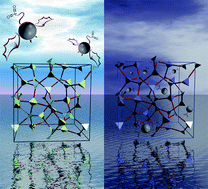The first issues of the newly formed Journal of Materials Chemistry A, B and C have been published online! Each journal showcases high impact research you expect from Journal of Materials Chemistry, now in three separate journals. For more information, please go to http://rsc.li/jmc-abc.
 Journal of Materials Chemistry A features articles on the following:
Journal of Materials Chemistry A features articles on the following:
Multifunctionality in metal@microgel colloidal nanocomposites, Jorge Pérez-Juste and Luis M. Liz-Marzán et al.: This Highlight describes recent developments related to hybrid nanocomposites comprising a metal core and a smart microgel shell.
Naturally occurring iron oxide nanoparticles: morphology, surface chemistry and environmental stability, Haibo Guo and Amanda S. Barnard : There is much to be learned from the simple and effective materials chemistry of naturally occurring nanomaterials.
Aluminum-stabilized NASICON-structured Li3V2(PO4)3, John B. Goodenough et al.: The redox couple, V4+/V3+, exhibits a potential of 3.76 V in NASICON-structured Li3Al0.1V1.9(PO4)3, which is suitable for a cathode material of a lithium-ion battery.
Importance of small micropores in CO2 capture by phenolic resin-based activated carbon spheres, Nilantha P. Wickramaratne and Mietek Jaroniec: Phenolic resin-based carbon spheres obtained by a slightly modified Stöber method are shown to be superior CO2 adsorbents.

Journal of Materials Chemistry B features articles on the following:
Biomimetic intracellular matrix (ICM) materials, properties and functions. Full integration of actuators and sensors, Toribio F. Otero and Jose G. Martinez: The electrochemistry of conducting polymers, and other organic compounds, originates biomimetic (intracellular matrix, ICM, reactive gels) materials, properties and devices here reviewed.
Cellular uptake and gene delivery using layered double hydroxide nanoparticles, Jun Lu, David G. Evans and Dermot O’Hare: The cellular uptake of fluorescein labelled 20 nm LDH nanoparticles into NSC 34 cells as a function of LDH particle concentration and incubation time was studied. The 20 nm LDH nanoparticles can also act as a DNA delivery agent to NSC 34 cell nuclei.
Biocompatible reduction-responsive polypeptide micelles as nanocarriers for enhanced chemotherapy efficacy in vitro, Xuesi Chen et al.: Biocompatible reduction-responsive micelles of disulfide-linked methoxyl poly(ethylene glycol) and poly(ε-benzyloxycarbonyl-L-lysine) block copolymers were developed for efficient intracellular drug delivery.
Theoretical understanding of single-stranded DNA assisted dispersion of graphene, Swapan K. Pati et al.: Using atomistic molecular dynamics (MD) simulation, we investigate the structure and energetic of single-stranded DNA (ssDNA) assisted solubilisation of single-layer graphene in aqueous medium at room temperature.
 Journal of Materials Chemistry C features articles on the following:
Journal of Materials Chemistry C features articles on the following:
Pyroelectric and electrocaloric materials, Q. M. Zhang et al.: This review summarizes typical properties of electrocaloric and pyroelectric materials and discusses related phenomena, and examines the relationship between these effects.
Graphenylene, a unique two-dimensional carbon network with nondelocalized cyclohexatriene units, Klaus Müllen and Linjie Zhi et al.: The unique structure and properties of a new hypothetical two-dimensional sp2-carbon network which is called graphenylene, have been predicted.
A deep-blue emitting charged bis-cyclometallated iridium(III) complex for light-emitting electrochemical cells, Wiebke Sarfert, Enrique Ortí, Michael Grätzel and Etienne Baranoff et al.: A cationic iridium(III) complex based on 2′,6′-difluoro-2,3′-bipyridine shows deep-blue emission in a concentrated film and is used in light-emitting electrochemical cells.
The design and investigation of porphyrins with liquid crystal properties at room temperature, Ross W. Boyle and Georg H. Mehl et al.: Porphyrins linked via hydrocarbon and siloxane spacers to cyanobiphenyls exhibit semectic LC behaviour at room temperature, confirmed by OPM, DSC and XRD.
Follow the latest journal news on Twitter @JMaterChem or go to our Facebook page.
To keep up-to-date with all the latest research, sign-up to our RSS feed or Table of contents alert.
C2TC00283C






















